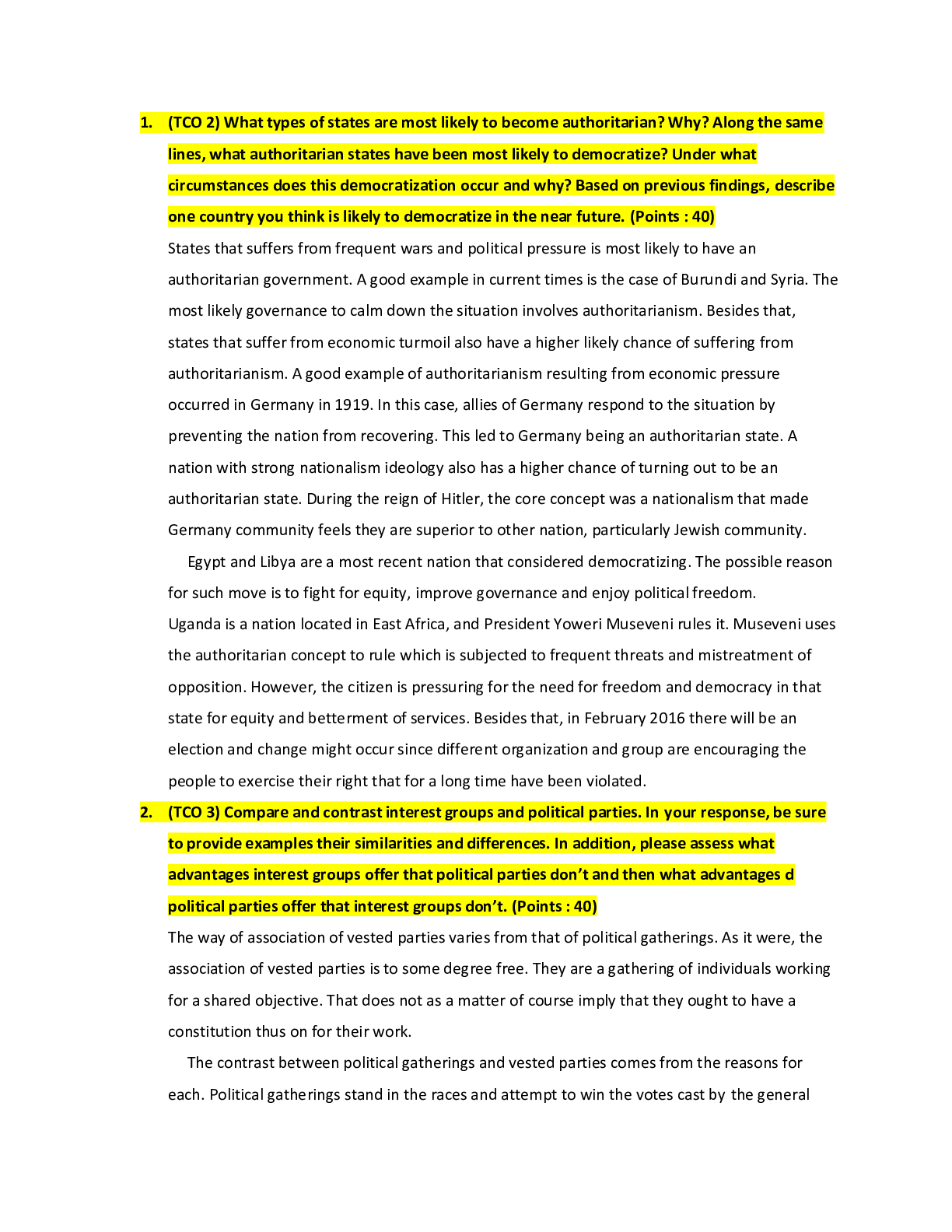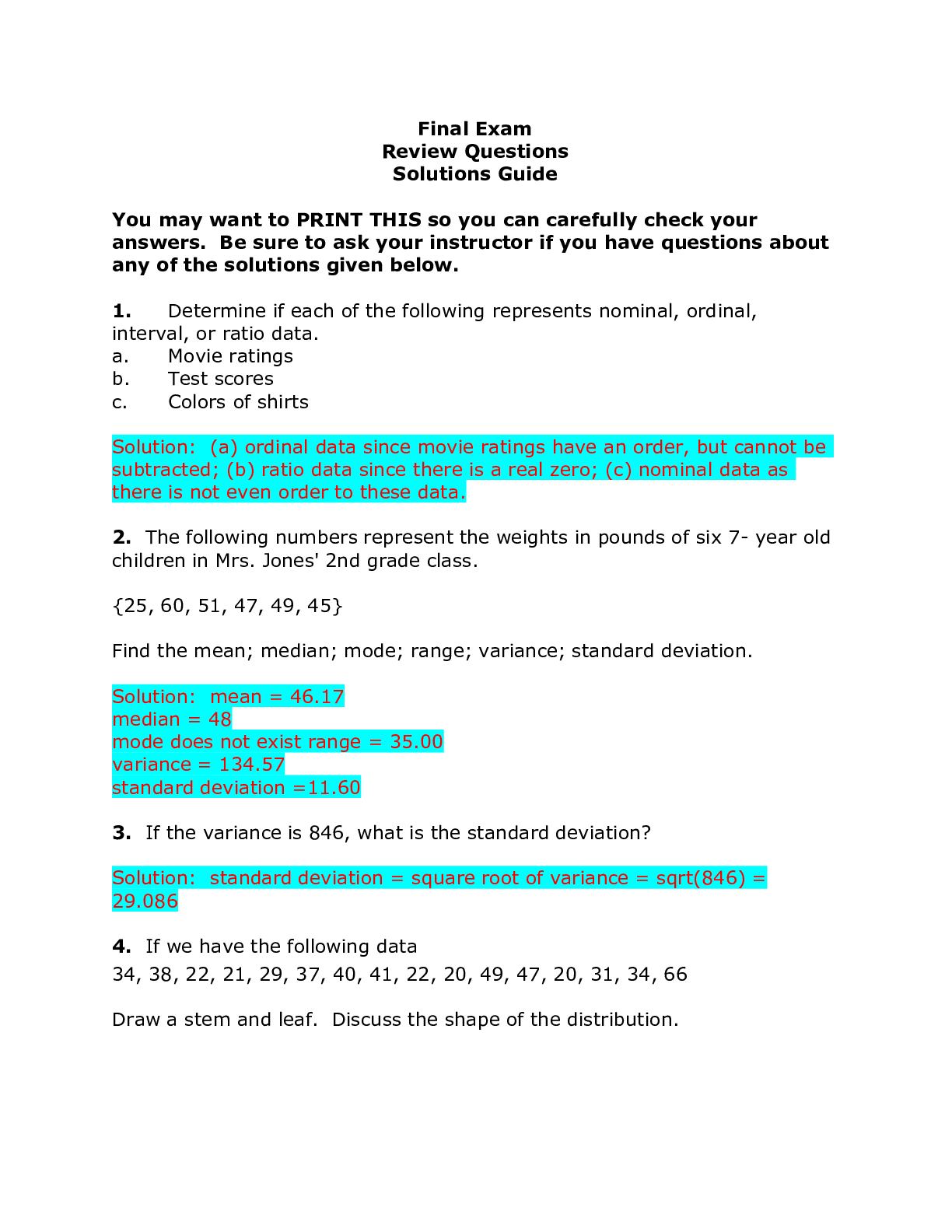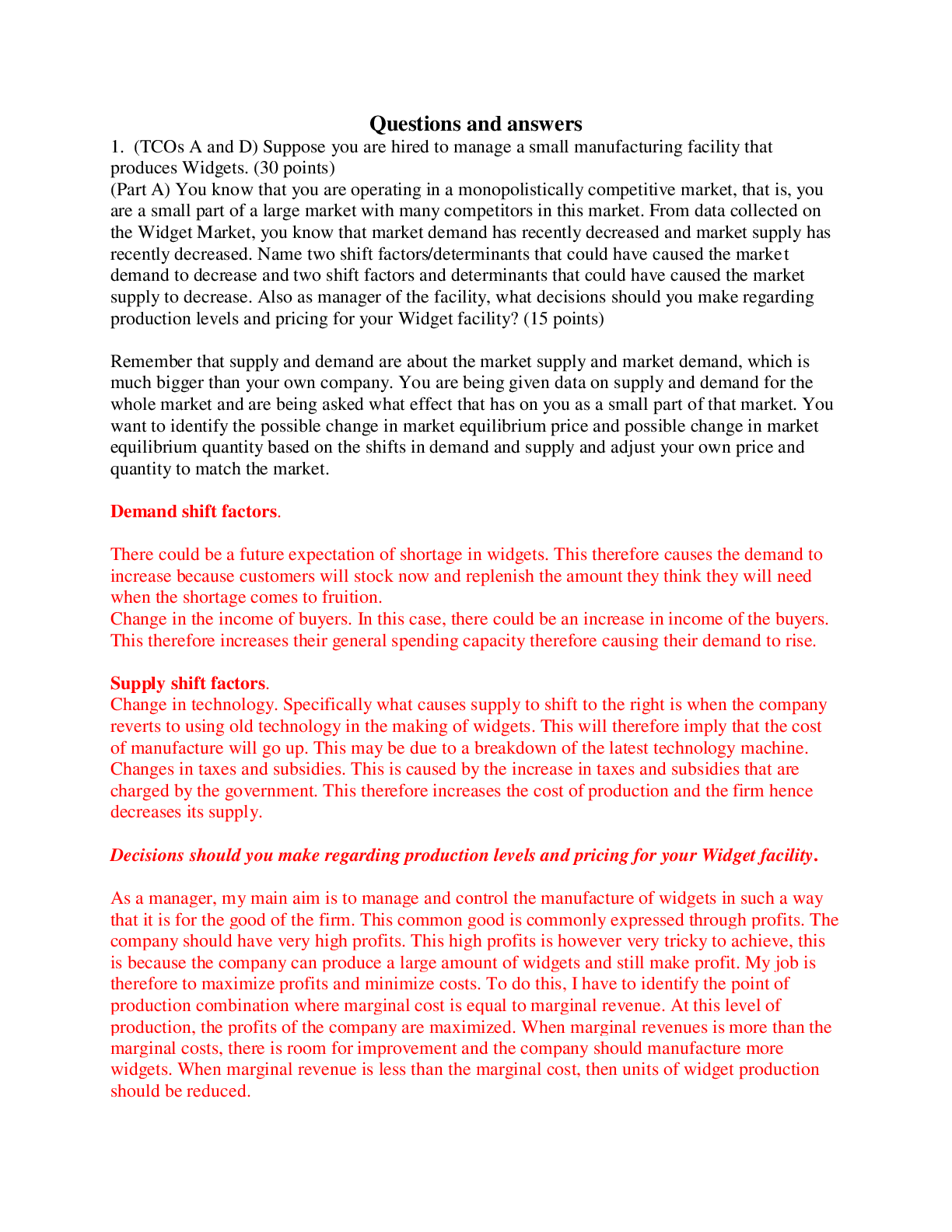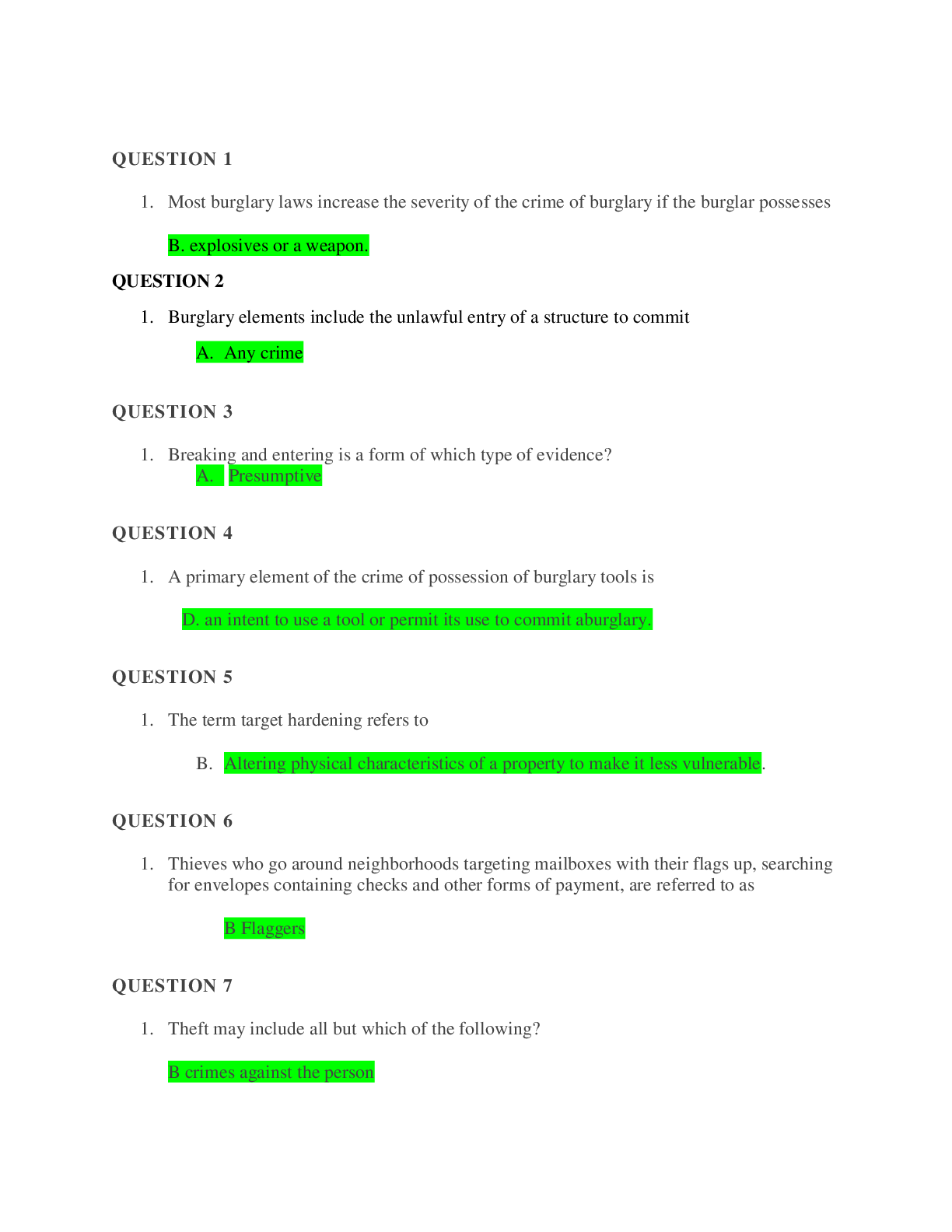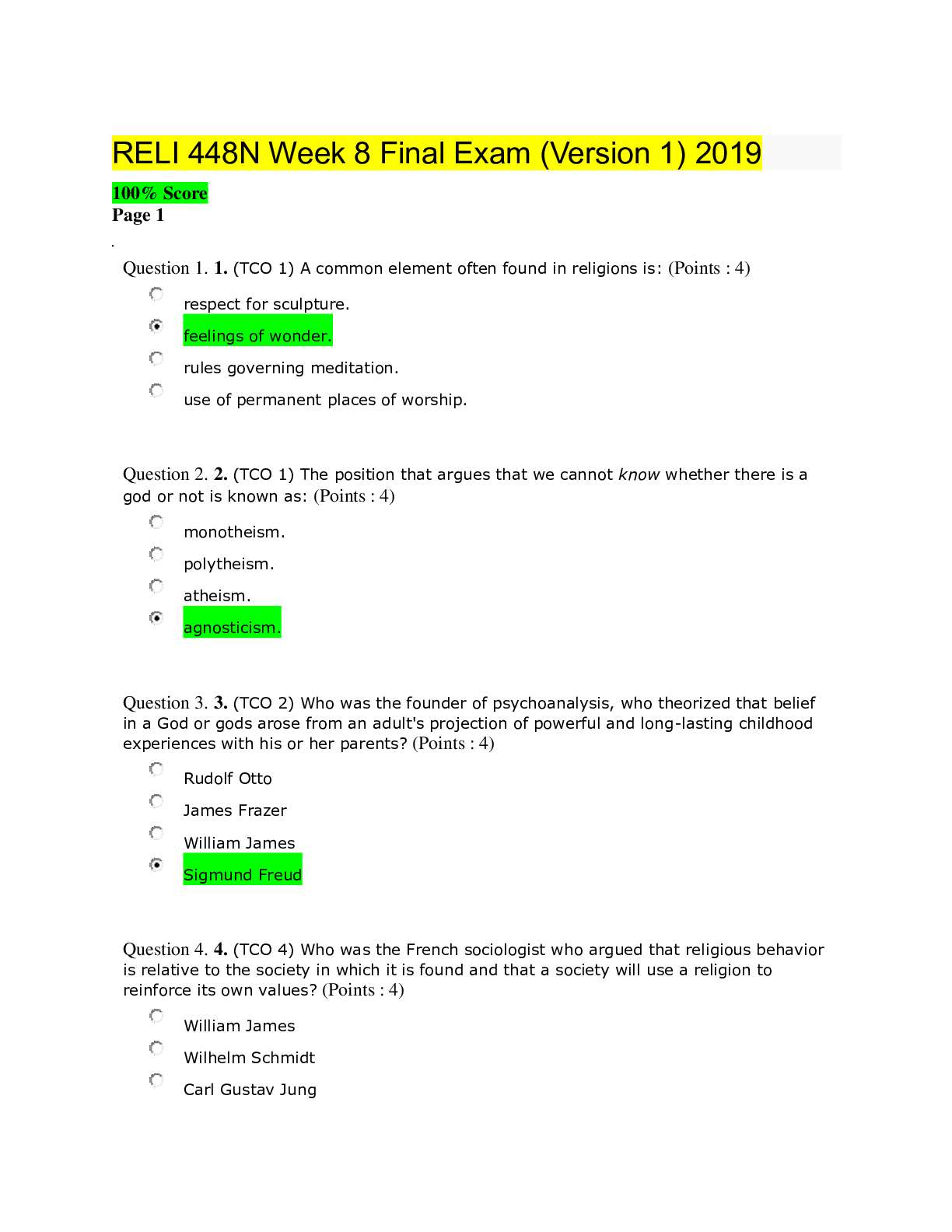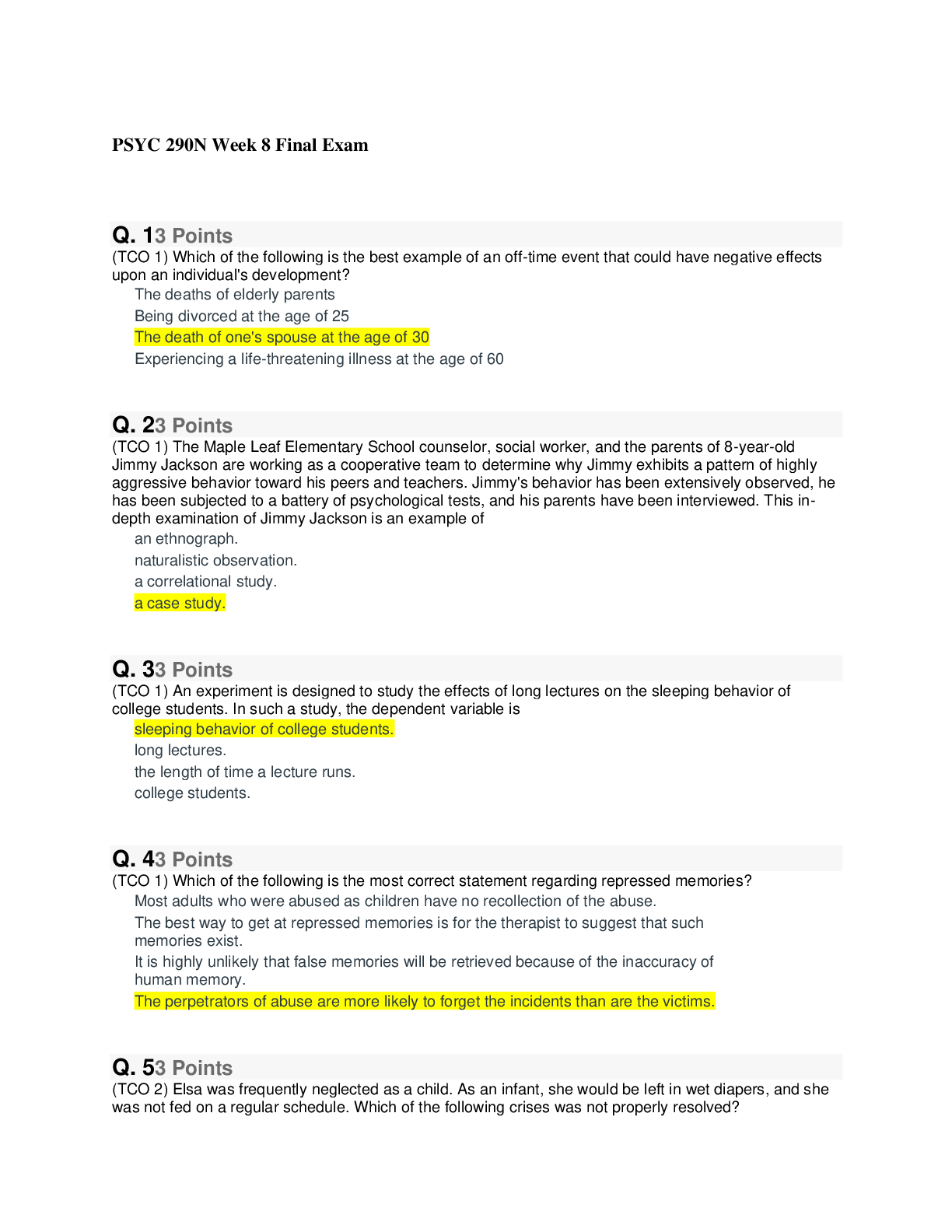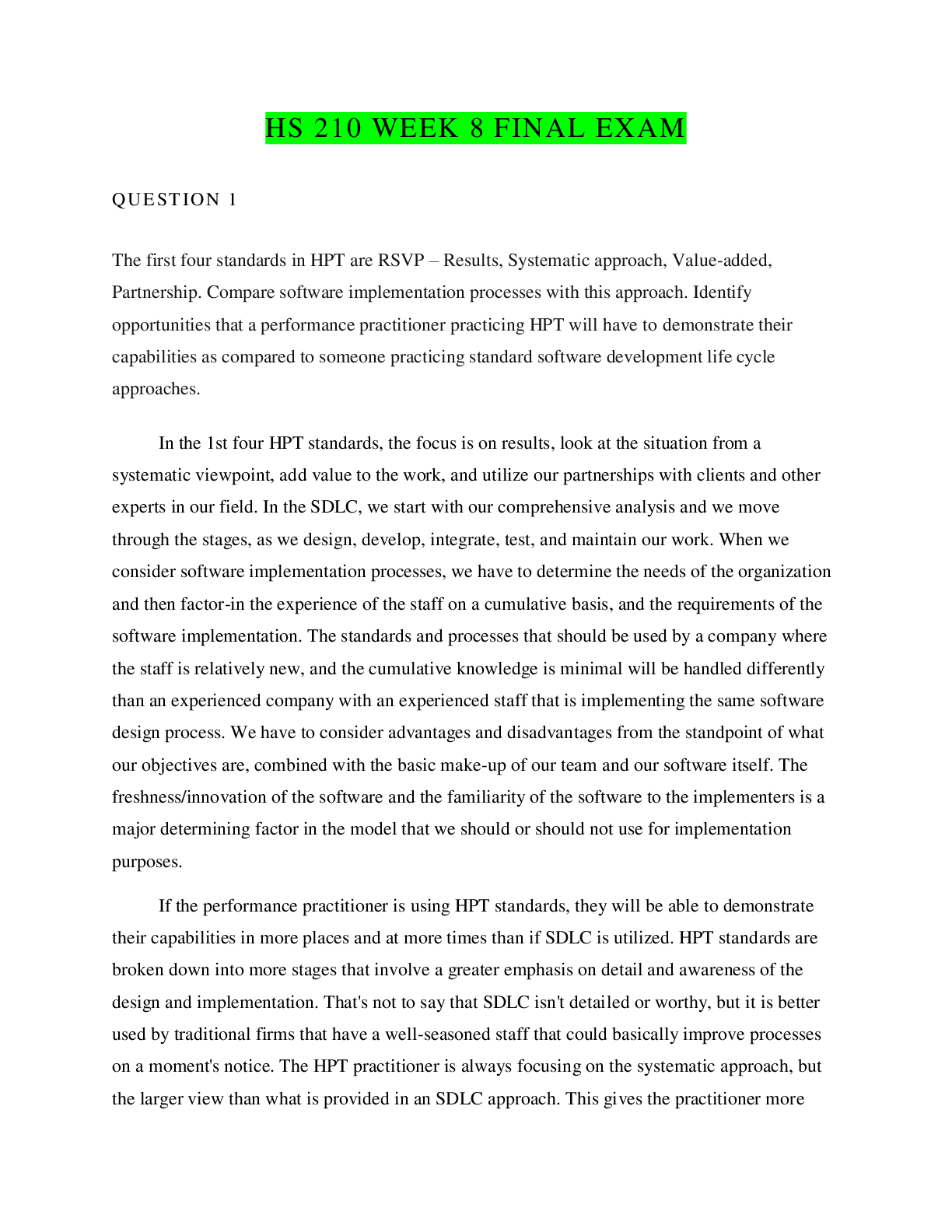*NURSING > EXAM > NR 507 Week 8 Final Exam (Updated 2021): Advanced Pathophysiology All answers correct With Explanati (All)
NR 507 Week 8 Final Exam (Updated 2021): Advanced Pathophysiology All answers correct With Explanations, Already graded A
Document Content and Description Below
NR507 Week 8 Final Exam / NR 507 Week 8 Final Exam (Latest): Advanced Pathophysiology: Chamberlain College of Nursing Chamberlain NR 507 Final Exam / Chamberlain NR507 Final Exam (Latest): Advanced Pa... thophysiology Question 1 Tissue damage caused by the deposition of circulating immune complexes containing an antibody against the host DNA is the cause of which disease? Hemolytic anemia Pernicious anemia Systemic lupus erythematosus Myasthenia gravis Question 2 How does chest wall compliance in an infant differ from that of an adult? An adult’s chest wall compliance is lower than an infant’s. An adult’s chest wall compliance is higher than an infant’s. An adult’s chest wall compliance is the same as an infant’s. An adult’s chest wall compliance is dissimilar to that of an infant’s. Question 3 What term is used to describe a hernial protrusion of a saclike cyst that contains meninges, spinal fluid, and a portion of the spinal cord through a defect in a posterior arch of a vertebra? Encephalocele Meningocele Spina bifida occulta Myelomeningocele Question 4 Continued therapy of pernicious anemia (PA) generally lasts how long? 6 to 8 weeks 8 to 12 months Until the iron level is normal The rest of one’s life Question 5 Cytokines are thought to cause fevers by stimulating the synthesis of which chemical mediator? Leukotriene Histamine Prostaglandin Bradykinin Question 6 The World Health Organization (WHO) defines grade 1 (overweight) as a BMI of: 18.5 to 24.9 25 to 29.9 30 to 39.9 40 to 50.9 IncorrectQuestion 7 When diagnosed with hemolytic disease of the newborn (HDN), why does the newborn develop hyperbilirubinemia after birth but not in utero? Excretion of unconjugated bilirubin through the placenta into the mother’s circulation is no longer possible. Hemoglobin does not break down into bilirubin in the intrauterine environment. The liver of the fetus is too immature to conjugate bilirubin from a lipid-soluble to water-soluble form. The destruction of erythrocytes producing bilirubin is greater after birth. Question 8 Which of the following describes how the body compensates for anemia? Increasing rate and depth of breathing Decreasing capillary vasoconstriction Hemoglobin holding more firmly onto oxygen Kidneys releasing more erythropoietin Question 9 An infant has a continuous machine-type murmur best heard at the left upper sternal border throughout systole and diastole, as well as a bounding pulse and a thrill on palpation. These clinical findings are consistent with which congenital heart defect? Atrial septal defect (ASD) Ventricular septal defect (VSD) Patent ductus arteriosus (PDA) Atrioventricular canal (AVC) defect Question 10 Research has shown a link between cancer and which sexually transmitted disease? Syphilis Gonorrhea Human papillomavirus Pelvic inflammatory disease Question 11 When renin is released, it is capable of which action? Inactivation of autoregulation Direct activation of angiotensin II Direct release of antidiuretic hormone (ADH) Formation of angiotensin I Question 12 What characteristic do atopic individuals have that make them genetically predisposed to develop allergies? Greater quantities of histamine More histamine receptors Greater quantities of IgE A deficiency in epinephrine Question 13 What is the primary cause of the symptoms of polycythemia vera? Decreased erythrocyte count Destruction of erythrocytes Increased blood viscosity Neurologic involvement Question 14 Pressure in the left ventricle must exceed pressure in which structure before the left ventricle can eject blood? Superior vena cava Aorta Inferior vena cava Pulmonary veins Question 15 Children with phenylketonuria (PKU) are unable to synthesize: Essential amino acid, phenylalanine, to tyrosine Renin, erythropoietin, and antidiuretic hormone Aldosterone, cortisol, and androgens Question 16 What is the chance with each pregnancy that a child born to two parents with the sickle trait will have sickle cell disease (SCD)? 20% 25% 33% 50% Question 17 Carcinoma refers to abnormal cell proliferation originating from which tissue origin? Blood vessels Epithelial cells Connective tissue Glandular tissue Question 18 Chvostek and Trousseau signs indicate which electrolyte imbalance? Hypokalemia Hyperkalemia Hypocalcemia Hypercalcemia Question 19 The ability of the pathogen to invade and multiply in the host is referred to as: Infectivity Toxigenicity Pathogenicity Virulence Question 20 An infant has a crescendo-decrescendo systolic ejection murmur located between the second and third intercostal spaces along the left sternal border. A wide fixed splitting of the second heart sound is also found. These clinical findings are consistent with which congenital heart defect? Atrial septal defect (ASD) Ventricular septal defect (VSD) Patent ductus arteriosus (PDA) Atrioventricular canal (AVC) defect Question 21 Which cancer originates from connective tissue? Osteogenic sarcoma Basal cell carcinoma Multiple myeloma Adenocarcinoma Question 22 Which substance is used to correct the chronic anemia associated with chronic renal failure? Iron Erythropoietin Cobalamin (vitamin B12) Folate Question 23 Which of the following are formed elements of the blood that are not cells but are disk-shaped cytoplasmic fragments essential for blood clotting? Monocytes Platelets Macrophages Erythrocytes Question 24 What is the term for a herniation or protrusion of brain and meninges through a defect in the skull? Encephalocele Meningocele Arachnoidocele Cephacephalocele Question 25 A hypersensitivity reaction that produces an allergic response is called: Hemolytic shock Anaphylaxis Necrotizing vasculitis Systemic erythematosus Question 26 Which characteristic is true of type II (white fast-motor) muscle fibers? Slow contraction speed Fast conduction velocities Profuse capillary supply Oxidative metabolism Question 27 What type of fracture occurs at a site of a preexisting bone abnormality and is a result of a force that would not normally cause a fracture? Idiopathic Incomplete Pathologic Greenstick Question 28 What part of the brain provides the emotional response to pain? Limbic system Parietal lobe Thalamus Hypothalamus Question 29 The portion of the pituitary that secretes oxytocin is: Posterior Inferior Anterior Superior Question 30 Which dyskinesia involves involuntary movements of the face, trunk, and extremities? Paroxysmal Tardive Hyperkinesia Cardive Question 31 Which term is also used to refer to paradoxic sleep? Non-REM Light REM Delta wave Question 32 Which clinical manifestations would be expected for a child who has complete trisomy of the twenty-first chromosome? Widely spaced nipples, reduced carrying angle at the elbow, and sparse body hair An IQ of 25 to 70, low nasal bridge, protruding tongue, and flat, low-set ears High-pitched voice, tall stature, gynecomastia, and an IQ of 60 to 90 Circumoral cyanosis, edema of the feet, short stature, and mental slowness IncorrectQuestion 33 Where is oxytocin synthesized? Hypothalamus Paraventricular nuclei Anterior pituitary Posterior pituitary IncorrectQuestion 34 What is the most common opportunistic infection associated with acquired immunodeficiency syndrome (AIDS)? Non-Hodgkin lymphoma Kaposi sarcoma Toxoplasmosis Cytomegalovirus Question 35 Atrial fibrillation, rheumatic heart disease, and valvular prosthetics are risk factors for which type of stroke? Hemorrhagic Thrombotic Embolic Lacunar Question 36 How many days does it take for the entire epithelial population of the small intestines to be replaced? 30 to 45 15 to 25 7 to 15 4 to 7 Question 37 What term describes the loss of the comprehension or production of language? Agnosia Aphasia Akinesia Dysphasia Question 38 Open-angle glaucoma occurs because of: Decreased production of aqueous humor Increased production of vitreous humor Obstructed outflow of aqueous humor Excessive destruction of vitreous humor Question 39 What is the most common malignant bone tumor diagnosed during childhood? Chondrosarcoma Fibrosarcoma Ewing Sarcoma Osteosarcoma Question 40 What is the cause of familial hypercholesterolemia (FH)? Diet high in saturated fats Increased production of cholesterol by the liver Reduction in the number of low-density lipoprotein (LDL) receptors on cell surfaces Abnormal function of lipoprotein receptors circulating in the blood Question 41 Which risk factor for hypertension is influenced by genetic factors and lifestyle? Sodium intake Physical inactivity Psychosocial stress Obesity Question 42 Which substance is a water-soluble protein hormone? Thyroxine Aldosterone Follicle-stimulating hormone Insulin Question 43 When does the male body begin to produce sperm? Before birth Shortly after birth At puberty When erection is possible Question 44 Saliva contains which immunoglobulin (Ig)? IgA IgE IgG IgM Question 45 Which serum laboratory test is elevated in all forms of osteogenesis imperfecta? Phosphorus Calcium Alkaline phosphatase Total protein Question 46 What causes the crystallization within the synovial fluid of the joint affected by gouty arthritis? Reduced excretion of purines Overproduction of uric acid Increase in the glycosaminoglycan levels Overproduction of proteoglycans Question 47 Acute glomerulonephritis (AGN) may be accompanied by a positive throat or skin culture for which bacteria? Staphylococcus aureus Streptococcus Pseudomonas aeruginosa Haemophilus Question 48 Considering the mediating factors of premenstrual syndrome (PMS), which medication may be used either continually or only during the menstrual period as a treatment for the condition? NSAIDs Estrogen SSRIs Progesterone Question 49 What is the second most commonly recognized genetic cause of mental retardation? Down syndrome Fragile X syndrome Klinefelter syndrome Turner syndrome Question 50 Insulin transports which electrolyte in the cell? Potassium Calcium Sodium Phosphorus Question 51 Which hormone stimulates gonads to produce both male and female hormones? Gonadotropin-releasing hormone (GnRH) Follicle-stimulating hormone (FSH) Luteinizing hormone (LH) Estrogen Question 52 The secretion of adrenocorticotropic-stimulating hormone (ACTH) will result in the increased level of which hormone? Thyroxine Insulin Cortisol. Antidiuretic hormone Question 53 Antipsychotic drugs block which neurotransmitter receptor? Norepinephrine Gamma-aminobutyric acid Serotonin Dopamine Question 54 In 95% of children of delayed puberty, the problem is caused by: Disruption in the hypothalamus Disruption of the pituitary Deficit in estrogen or testosterone Physiologic hormonal delays Question 55 Which clinical manifestations are associated with fibromyalgia? Hot, tender, and edematous muscle groups bilaterally Fasciculations of the upper and lower extremity muscles Exercise intolerance and painful muscle cramps Sensitivity at tender points and profound fatigue Question 56 What happens to the vagina’s lining at puberty? It becomes thinner. It becomes thicker. It assumes a neutral pH. It undergoes atrophy. Question 57 What is the first sign of puberty in girls? Breast enlargement Growth of pubic hair Menstruation Vaginal discharge Question 58 Which term is used to identify the temporary displacement of two bones causing the bone surfaces to partially lose contact? Dislocation Subluxation Malunion Nonunion Question 59 What is the basic structural unit in compact bone? Small channels called canaliculi Osteocytes within the lacunae Tiny spaces within the lacunae Haversian system Question 60 What anchors articular cartilage to the underlying bone? Sharpey fibers Collagen fibers Glycoproteins Elastin fibers Question 61 Thyroid-stimulating hormone (TSH) is released to stimulate thyroid hormone (TH) and is inhibited when plasma levels of TH are adequate. This is an example of: Positive feedback Negative feedback Neural regulation Physiologic regulation Question 62 Clinical manifestations that include irregular or heavy bleeding, the passage of large clots, and the depletion of iron stores support which diagnosis? Premenstrual syndrome Dysfunctional uterine bleeding Polycystic ovary syndrome Primary dysmenorrhea Question 63 The absence of which major hormone is a determinant of sexual differentiation (wolffian system) in utero? Estrogen Progesterone Growth hormone Testosterone Question 64 Obesity acts as an important risk factor for type 2 diabetes mellitus by: Reducing the amount of insulin the pancreas produces Increasing the resistance to insulin by cells Obstructing the outflow of insulin from the pancreas Stimulating the liver to increase glucose production Question 65 Which hormone is involved in the regulation of serum calcium levels? Parathyroid hormone (PTH) Thyroxine (T4) Adrenocorticotropic hormone (ACTH) Triiodothyronine (T3) Question 66 An insufficient dietary intake of which vitamin can lead to rickets in children? C B12 B6 D Question 67 What is the function of the mucus secreted by the Bartholin glands? Enhancement of the motility of sperm Lubrication of the urinary meatus and vestibule Maintenance of an acid-base balance to discourage proliferation of pathogenic bacteria Enhancement of the size of the penis during intercourse Question 68 Which hormone triggers uterine contractions? Thyroxine Oxytocin Growth hormone Insulin Question 69 Which bones are affected in Legg-Calvé-Perthes disease? Heads of the femur Distal femurs Heads of the humerus Distal tibias Question 70 An individual’s genetic makeup is referred to as his or her: Phenotype Genotype Heterozygous locus Homozygous locus Question 71 What term is used to identify the calcium crystals that are associated with chronic gout? Stones Spurs Tophi Nodes Question 72 Which gastric cells secrete hydrochloric acid and intrinsic factor? Parietal Chief G H Question 73 A criterion for a diagnosis of generalized anxiety disorder (GAD) is a period of excessive worrying that lasts for at least how many months? 3 6 9 12 Question 74 A major characteristic of type 1 diabetes mellitus is that there is: Partial insulin secretion An autoimmune cause factor Insulin resistance Obesity as a common risk factor Question 75 Dilation of the ipsilateral pupil, following uncal herniation, is the result of pressure on which cranial nerve (CN)? Optic (CN I) Abducens (CN VI) Oculomotor (CN III) Trochlear (CN IV) [Show More]
Last updated: 2 years ago
Preview 1 out of 36 pages
.png)
Buy this document to get the full access instantly
Instant Download Access after purchase
Buy NowInstant download
We Accept:

Also available in bundle (1)

NR 507 Week 8 Final Exam PLUS Study Guide (Updated 2021): Advanced Pathophysiology All answers correct With Detailed Explanations, Already graded A Assured
NR 507 WEEK 8 FINAL EXAM UPDATED 2021
By Grade A Plus 4 years ago
$21.5
4
Reviews( 0 )
$11.50
Can't find what you want? Try our AI powered Search
Document information
Connected school, study & course
About the document
Uploaded On
Apr 23, 2021
Number of pages
36
Written in
Additional information
This document has been written for:
Uploaded
Apr 23, 2021
Downloads
0
Views
80










 (1).png)


